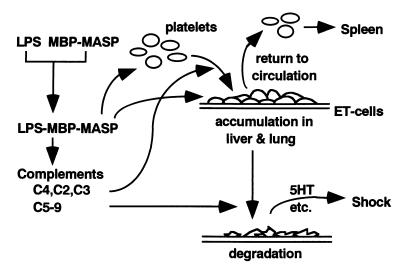FIG. 6.
Hypothetical pathway for the LPS-induced accumulation and degradation of platelets in the lungs and liver. In this tentative scheme, LPS is assumed to bind to MBP-MASP complex and a consequent complex stimulates MBP receptors on platelets and vascular endothelial (ET) cells in the liver and lungs. The LPS-MBP-MASP complex also activates the complement system. The pathway to form C3 convertase from C4 and C2 may be responsible for the accumulation of platelets in the liver and lungs. The pathway from C5 to C9 may be involved in the destruction of platelets, and the O antigen polysaccharide region of KO3-S LPS may be important in this step. The degradation of platelets in the liver and lungs and the release of their contents, including serotonin (5HT), lead rapidly to shock. When the complement system is not activated, or if its activation is insufficient, the platelets accumulated in the lungs and liver return to the circulation without degradation or with only slight damage. The platelets that suffer slight damage may be removed from the circulation by the spleen.

